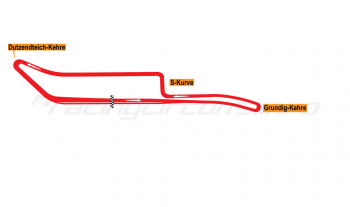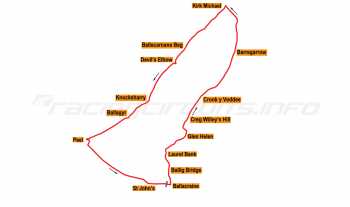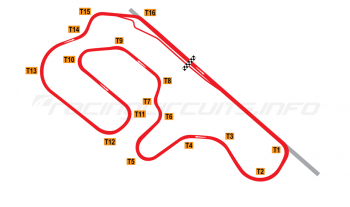Circuito IFEMA Madrid
Circuit Overview
Formula One is set to switch venues for the Spanish Grand Prix to a new course built around Madrid’s IFEMA exhibition centre.
The 20-turn, 5.474 km course will be a part-street circuit, part-permanent facility, with pit and paddock facilities located within the halls of the exhibition centre. The permanent section of track looks set to feature a steeply banked sweeping turn, providing a new challenge for F1’s drivers.
The final layout is subject to further design work overseen by the Italian Dromo company and is certain to evolve ahead of the race’s debut in 2026.
Circuit History
Rumours of a switch of Formula One’s Spanish event from Barcelona to its rival city of Madrid have abounded for some time, with the capital city keen to recapture a race it last hosted in 1981. The permanent circuit of Jarama was never in the running, however, with Formula One ever more keen to create destination events in city centres.
Planning for a Madrid Grand Prix got under way in earnest in 2022 and a deal was finally announced in January 2024. A 10-year contract has been agreed with the IFEMA Madrid exhibition centre to take over the race from 2026 for 10 years, seemingly dumping the Circuit de Catalunya-Barcelona from the calendar at the end of its current contract.

The circuit is set to be split across two primary zones; the first spanning IFEMA’s existing Recinto Ferial site – housing an array of halls, auditoriums and convention centres – and the second running through the Valdebebas northern expansion area, which will place it alongside the Real Madrid Sport City football training ground complex .
While the pits and paddock facilities will be temporary and housed within the IFEMA ’s exhibition halls, the permanent stretch of circuit will be built on currently undeveloped land. This is set to include a fast sweeping turn, which could feature high banking, bringing inevitable comparisons with the fabled Sitges oval course.
Developing the track design
F1 has worked through plenty of track models since talks with IFEMA and their representatives began, with renowned circuit designer Jarno Zaffelli of Italian specialists Dromo brought in over the last 12 months to refine the concepts further. The result is a 5.474km, 20-turn proposal, which boasts an estimated qualifying lap time of around 1 minute 32 seconds.

“From the very first suggestion to where we’ve ended up, there’s been about 24 track models, but then there’s been numerous sub-model investigations and different details as well,” explains F1’s Head of Vehicle Performance Craig Wilson, who has been involved in the process from the start. “We’ve now got a concept that we’re happy to proceed development with and we’re very excited to see it take shape.”
It’s a layout that features everything from fast sweeps to tight chicanes, and lengthy straights to short bursts of the throttle, offering a varied experience for those behind the wheel. “I think it will be a good challenge for the drivers,” adds Wilson.
With the race contract secured, in many senses the hard work begins now to make the track a reality. “The next steps are that it now needs to go from concept into detailed design development and importantly through the FIA submission and homologation process, and all the safety assessments, to achieve a Grade 1 track licence,” explains Wilson.
“As you start construction, it needs to go through all the inspections, while we have to work with the developers on all the planning, infrastructure, how the garages are going to be arranged, how the paddock layout specifics are going to be and all of our systems integration, so it’s the start of the journey.”
A lap of the track
If early simulations are anything to go by, it looks to be a high speed blast with more elevation change than might first be expected. There are even two tunnel sections, to go from the Recinto Ferial complex, under the M11 motorway and onto the Valdebebas expansion area and vice versa.
While the initial reaction on social media by F1 fans has been sceptical about how easy it will be to race on, it will offer something different, according to Wilson.
“It’s in between what you’d consider a normal street track layout and more towards a permanent circuit style layout,” Wilson comments. “A lot of the places will have a temporary circuit-type installation, but then there’s other sections which may look or feel a bit different depending on the final implementation decisions to suit the IFEMA site.”
An area of the circuit immediately namechecked by Wilson as one to watch is the run between Turn 7 to Turn 9, which is set to be “quite steeply downhill” thanks to the rise after the tunnel transition from Recinto Ferial and then the subsequent drop from public to private roads in Valdebebas.
Elsewhere, the large radius Turn 10 “has scope to be banked”, and discussions are ongoing as to “how banked we make it, what kind of banking and what kind of profile we go for, with a mind to how can we turn Turn 11 and Turn 12 into a potential overtaking action area”.
The following section from Turn 13 to Turn 17 will see drivers build up some serious speed between a collection of buildings and grandstands, making for an “ambitious” plan that should please both the drivers and the fans watching at the side of the track and on TV.
Sustainability is key
Ensuring the circuit and the race are as environmentally sustainable as possible was a key feature of the announcement. Easily reached by the city’s existing transport links on public transport, F1 and IFEMA believe 90 percent of fans will be able to reach the circuit via public transport or simply by walking.
The capacity of the circuit, which will feature both street and traditional circuit elements, will be around 110,000 fans per day, increasing to around 140,000 over the first five years of the agreements.
Even for those arriving internationally, the track’s location makes it a simple affair. Located in the Barajas district, just a stone’s throw away from the Adolfo Suarez airport and only 16 kilometres from the city centre, IFEMA has excellent car, bus, train and subway routes joining the locations.
Importantly, much of the track’s temporary infrastructure will be stored on site, within walking distance of where it will be erected, reducing the carbon footprint and removing the need for it to be stored elsewhere. It should also make setting up for the event each year that much simpler. IFEMA claim it will make Madrid the first ‘zero-kilometre GP’.
Circuit info
- IFEMA Madrid, Avda. del Partenón, 5, 28042 Madrid, Spain
- +34 91 722 30 00
- Email the circuit
- Official website
Rate This Circuit
Votes: 1638
Plan a visit
Get your race tickets!
Brought to you with: 
We've teamed up with Motorsports Tickets to bring you the best deals for Formula One, MotoGP, Le Mans and more.









